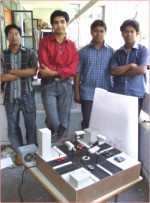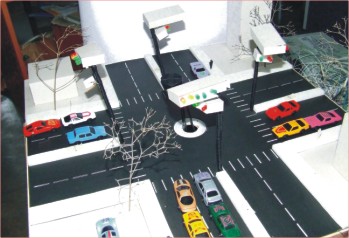| Innovation
Intelligent traffic Control System
Sadat Mazumder
Sanjib Saha
G.M Al-Mamun
M Zaman Shimul
Sazid Hasan
Course Supervisor:
Chowdhury Sayeed Haider
Mostofa Ali Patwary
 Nowadays we experience traffic jam on roads almost everywhere, all the time. It is horrible to be victim to a traffic jam. In the existing traffic system of Bangladesh, the traffic signals are repeated at certain time intervals, without taking into consideration the traffic load in the roads. It works at a constant time interval irrespective of the crowd density at any given time. So it is a very common that a nearly empty road is enjoying the green signal while a more congested road is stuck in the red signal. Nowadays we experience traffic jam on roads almost everywhere, all the time. It is horrible to be victim to a traffic jam. In the existing traffic system of Bangladesh, the traffic signals are repeated at certain time intervals, without taking into consideration the traffic load in the roads. It works at a constant time interval irrespective of the crowd density at any given time. So it is a very common that a nearly empty road is enjoying the green signal while a more congested road is stuck in the red signal.
We implemented a new system called an “Intelligent Traffic Control System”. We have tried to minimize traffic jams by assigning a predefined time slot to each of the roads according to their respective crowd densities. To measure the crowd density of the road, we took images of the roads and then analyzed the images to estimate crowd densities for each road. Sophisticated image processing algorithms have been used to make this approximation as accurate as possible. Then, according to these measurements, time slots are distributed among the roads. In this context, we call our system “Intelligent”.
The main motivation behind this project lies in the word Intelligent. In the conventional traffic control systems, the roads are assigned equal time durations irrespective of the crowd densities. But in our system we introduced intelligence through image analysis and thus divided the time slot according to traffic densities.
This system is also distributed. There is a central system (server) for a city or a large area. This central server is used to get data about the traffic condition of the corresponding road over the last few days at the same time of day. So we do not depend on the pictures of just one instant, but are also taking considering previous records.
The server is also used to get information about the road conditions. We can know the current situation of any road at any time, such as, whether a road is blocked for some construction work. This system takes care of these situations and gives necessary traffic signals to the appropriate roads, such as not allowing any cars to take that direction.
We also noticed that, sometimes even though a signal is green, there is no way for the traffic to go because the entry points are already heavily congested. This situation only increases traffic chaos. Our system also takes care of this situation. The part of the system located in the junctions gains data about other parts of the city and can take proper steps to avoid these situations.
We also provide road-wise priority facility for emergency vehicles such as ambulance, fire brigade trucks, VIP cars etc. There are provisions for road blocking in case of construction or public meetings. All aspects of the project have made it intelligent in the true sense of the world.
Another aspect can be added to the system. Provision for detecting traffic rule violations can be introduced as well.
Considering the problems posed by the current traffic control system in our country, we can hope that our “Intelligent traffic control system” can easily alleviate the problems stated above.
Problem Statement:
The main task of this traffic system is to maintain the best possible flow of vehicles in a traffic junction. To do this we have to consider the following aspects-
Ø In the traffic signals there are many roads. We have to let the sides go in such a way so that no collision occurs. Here we have designed our program in such a way so that maximum roads can be opened at a time while avoiding collision.
Ø In the signal there must be allowance for pedestrians. Here we have pedestrian roads open only when there is no traffic allowed on either lane so that no accident can take place.
Ø In case of roadblocks, we have considered the incoming side as being blocked. So that direction is closed. As our system is distributed, we always have information about any road such as whether it is closed or not. Then we set the signal of that road to off.
Ø There is a provision for emergency vehicles. In such cases, the road is open until the emergency switch is turned off. If there are two requests for emergency, it is assigned using their priority.
Ø While implementing an intelligent traffic control system, we have checked that most congested roads have green lights on for longer than a less congested road.
Ø We always rotate through the green lights, unless any road is blocked or is having emergency protocol, so that no road experiences starvation.
Ø We have assigned the time intervals using not only the current traffic density, but also previous records at that time slot. We have updated this information to a central server regularly.
This is the main problem specification. More details are discussed later.
Block Diagram:
The logical block diagram of our system is presented here:
For more details about this project:
sanjib1985@gmail.com
mamun_gm@yahoo.co (BUET)
Copyright
(R) thedailystar.net 2007 |
